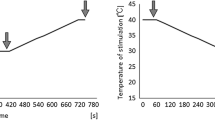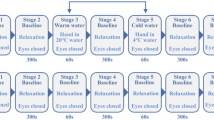Abstract
We have previously reported the unique regional responses of facial skin blood flow (SkBF) to oral application of the basic tastes without simultaneous systemic circulatory changes. In the present study, we determined whether a systemic circulatory challenge due to sympathetic activation induces regional differences in facial SkBF by observing the responses in facial SkBF and blood pressure to a 2-min cold pressor test (CPT) and static handgrip exercise (HG) by right hand in 20 healthy subjects. The CPT significantly increased SkBF in the forehead, eyelid, cheek, upper lip and lower lip by 6 ± 2 to 8 ± 2 % (mean ± SEM) as compared to resting baseline, with a significant simultaneous increase (13 ± 2 %) in mean arterial pressure (MAP), whereas it significantly decreased the SkBF in the nose by 5 ± 2 %. The HG significantly increased SkBF in the forehead, cheek and lower lip by 6 ± 3 to 10 ± 3 %, with a significant simultaneous increase in MAP (13 ± 2 %), while it induced no significant change in the other regions. Increases in SkBF were greater in the right than left cheek during CPT. These results demonstrate that a systemic circulatory challenge via sympathetic activation elicits regional differences in the facial SkBF response.
Access this article
We’re sorry, something doesn't seem to be working properly.
Please try refreshing the page. If that doesn't work, please contact support so we can address the problem.




Similar content being viewed by others
References
Bergersen TK (1993) A search for arteriovenous anastomoses in human skin using ultrasound Doppler. Acta Physiol Scand 147:195–201
Blair DA, Glover WE, Roddie IC (1961) Cutaneous vasomotor nerves to the head and trunk. J Appl Physiol 16:119–122
Drummond PD (1995) Mechanisms of physiological gustatory sweating and flushing in the face. J Auton Nerv Syst 52:117–124
Drummond PD (1997) The effect of adrenergic blockade on blushing and facial flushing. Psychophysiology 34:163–168
Drummond PD (2006) Immersion of the hand in ice water releases adrenergic vasoconstrictor tone in the ipsilateral temple. Auton Neurosci 128:70–75
Drummond PD, Chung C (2012) Immersing the foot in painfully-cold water evokes ipsilateral extracranial vasodilatation. Auton Neurosci 166:89–92
Drummond PD, Granston A (2003) Facilitation of extracranial vasodilatation to limb pain in migraine sufferers. Neurology 61:60–63
Drummond PD, Mirco N (2004) Staring at one side of the face increases blood flow on that side of the face. Psychophysiology 41:281–287
Fox RH, Goldsmith R, Kidd DJ (1962) Cutaneous vasomotor control in the human head, neck and upper chest. J Physiol 161:298–312
Hayashi N, Someya N, Maruyama T, Hirooka Y, Endo MY, Fukuba Y (2009) Vascular responses to fear-induced stress in humans. Physiol Behav 98:441–446
Kashima H, Hayashi N (2011) Basic taste stimuli elicit unique responses in facial skin blood flow. PLoS One 6:e28236
Karita K, Izumi H (1992) Somatosensory afferents in the parasympathetic vasodilator reflex in cat lip. J Auton Nerv Syst 39:229–234
Kemppainen P, Forster C, Handwerker HO (2001) The importance of stimulus site and intensity in differences of pain-induced vascular reflexes in human orofacial regions. Pain 91:331–338
Kuraoka K, Nakamura K (2011) The use of nasal skin temperature measurements in studying emotion in macaque monkeys. Physiol Behav 102:347–355
Larochette AC, Chambers CT, Craig KD (2006) Genuine, suppressed and faked facial expressions of pain in children. Pain 126:64–71
Niedenthal PM (2007) Embodying emotion. Science 316:1002–1005
Nordin M (1990) Sympathetic discharges in the human supraorbital nerve and their relation to sudo- and vasomotor responses. J Physiol 423:241–255
Saito M, Mano T, Iwase S (1990) Changes in muscle sympathetic nerve activity and calf blood flow during static handgrip exercise. Eur J Appl Physiol Occup Physiol 60:277–281
Victor RG, Leimbach WN Jr, Seals DR, Wallin BG, Mark AL (1987) Effects of the cold pressor test on muscle sympathetic nerve activity in humans. Hypertension 9:429–436
White MD, Cabanac M (1995) Nasal mucosal vasodilatation in response to passive hyperthermia in humans. Eur J Appl Physiol Occup Physiol 70:207–212
Acknowledgments
This work was partly supported by a grant from the Uehara Memorial Foundation (to N.H.).
Author information
Authors and Affiliations
Corresponding author
Additional information
Communicated by Massimo Pagani.
Rights and permissions
About this article
Cite this article
Kashima, H., Ikemura, T. & Hayashi, N. Regional differences in facial skin blood flow responses to the cold pressor and static handgrip tests. Eur J Appl Physiol 113, 1035–1041 (2013). https://doi.org/10.1007/s00421-012-2522-6
Received:
Accepted:
Published:
Issue Date:
DOI: https://doi.org/10.1007/s00421-012-2522-6




